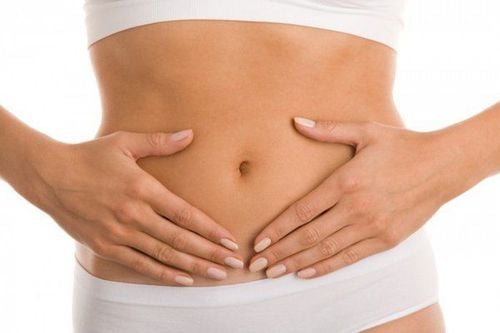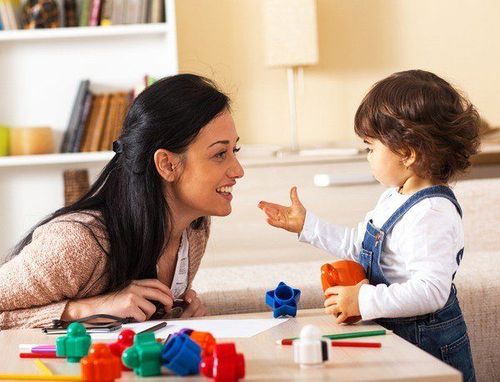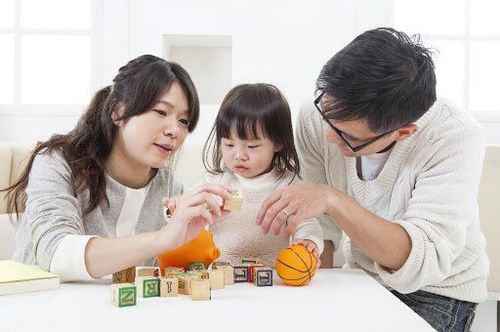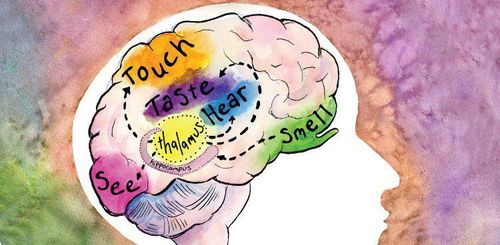This is an automatically translated article.
The article was consulted with Specialist II Chung Thi Mong Thuy - Pediatrician - Neonatologist - Department of Pediatrics - Neonatal, Vinmec Central Park International General Hospital.Touch is especially important for babies, especially in the first few months of life, it helps them connect mother-baby, interact with people and explore the world around them.
1. When does tactile development in infants take place?
Your baby's sense of touch begins to develop around the 7th to 8th week of pregnancy.At the 11th week, the baby starts to move in the womb. These movements mark the baby's first exploration of his environment and body.
After birth, the baby uses touch to sense the surrounding objects. It is also through it that children can feel their mother's love through the actions of holding, hugging, feeding, bathing and massaging.

Xúc giác của trẻ bắt đầu phát triển ngay từ tuần thứ 7 đến tuần thứ 8 của thai kỳ
2. Stages of tactile development in infants
A baby's sense of touch begins in the womb and continues to develop throughout the first years of life and beyond.2.1. Newborn period Newborn babies have very sensitive skin. Some areas of the baby's body are especially sensitive to touch, such as the mouth, cheeks, face, hands, belly, and soles of the feet.
At birth, skin-to-skin contact is an important thing to bond mother and child. The baby feels protected when touched by the mother's skin and responds by touching the mother's chin.
When you stroke your baby's palm, he will respond by squeezing your hand. Similarly, if you put any other object in the palm of your hand, your baby will grasp it too. Most of these reflexes disappear as the child gets older.
Baby's mouth is also very sensitive. Babies use their mouths as another way to learn and explore. Therefore, when you put your baby on your chest, he will use his mouth to find the nipple to suck on. Also, if you gently touch your baby's cheek, he'll turn his head and use his mouth to feel your hand.
2.2. 1-month-old stage At 1 month old, your baby's hands are mostly closed. When the finger is open, the child likes to use it to grab the parent's finger if it can be touched with the palm.
2.3. 2 to 3 months old Babies love the feeling of being touched by their parents and touching their chin. This is a gentle response for children to connect emotionally with their family. At this time, the baby's tongue, lips and mouth are very sensitive. Children use them to make sense of the objects around them.
Children do not pick up toys by themselves but enjoy holding them in their hands. At the age of 2 months to 3 months, babies are able to distinguish between hard and soft objects.
2.4. At 4 months old, your baby's muscles are developing strongly, especially in the arms and hands. This allows children to reach out and touch objects.
2.5. At 5 months old, babies begin to lift, hold, and grasp objects with both hands, but still use their mouths to feel their structure. This helps to form children's clear feelings for bathing, and they can distinguish between hot and cold water.

Khi được 5 tháng tuổi, trẻ bắt đầu tập nâng, cầm, nắm các đồ vật bằng cả hai tay nhưng vẫn dùng miệng để cảm nhận cấu trúc của chúng
2.7. 7 to 8 months old Baby's spatial awareness is developing. Combined with touch, children can distinguish between flat and multidimensional objects. Babies will feel excited when touching objects that have parts to grasp such as handles, parts that can be twisted or rotated.
This is also the stage when babies start crawling. Families should create conditions for children to have more contact with surrounding objects to enhance exploratory thinking.
2.8. 9 to 10 months old Babies move more and are always looking for new objects to touch. At this stage, children still use their mouth to learn about objects.
Children will love to pick up objects and put them in containers. Therefore, families should buy objects that are brightly colored or have moving but safe parts for children to continue to explore.
2.9. 11 to 12 months old When your baby is 1 year old, your baby will explore a variety of objects with different properties such as hard, soft, cold, wet, sticky and paste. Children no longer use their mouths, but use their hands to touch and feel objects.
3. The skin-to-skin method helps maximize children's sense of touch
Gently touching your baby's body, especially his back, is one of the best ways to soothe a baby, especially when he's fussy.Newborns love to be held, caressed, rocked because it feels comfortable. Children love to be near their parents, feeling the familiar warmth, smells, sounds, and sensations of their bodies.
“Kangaroo care” - hugs the newborn baby against the mother's bare chest, which maximizes skin-to-skin contact between mother and baby. Studies show it can help improve blood oxygen levels, reduce crying, improve sleep, and help your baby breastfeed more effectively.
For mothers, close skin-to-skin contact with babies has the effect of regulating blood pressure and hormone levels in the body. When you hold your baby in your arms, your body releases oxytocin, also known as the love hormone. Studies have found that the oxytocin levels of fathers can also increase after exposure to their children.
Children also love to be massaged . Regular baby massage will help in strengthening the connection between mother and child. This activity encourages parents to do the same.

Chạm nhẹ nhàng vào cơ thể bé, đặc biệt là vùng lưng, là một trong những cách tốt nhất để xoa dịu trẻ
4. How to develop a baby's sense of touch?
Here are a few ways that can help:Exposure to a variety of colorful toys and objects around: Families can stimulate this development by letting their baby play with toys with different styles and properties (smooth, rough, hard or soft), with sound, suitable for children's ages. Books with textures, fabrics, feathers, hardcovers can help. When your baby is old enough, you can let him play with sand, clay or water. Exposing your baby to food: When your baby starts solids, let him touch and play with food. Although it feels dirty and messy, it's a good learning experience for your baby. This action can encourage children to try new foods, giving them the opportunity to use their fingers and hands to learn about food. Children continue to explore food with their tongue, after putting it in their mouth. Baby massage : Massage provides skin-to-skin contact, especially important in the early days, to help strengthen bonding and comfort, especially needed for premature babies. to respond appropriately to the child's wishes: Families should pay attention to the child's response to touch patterns in order to recognize the child's feelings towards them. From there, come up with a way to soothe the child. In addition, in order to prevent diseases that babies often get, parents should pay attention to a diet to improve the child's resistance. At the same time, add supporting foods containing lysine, essential micro-minerals and vitamins such as zinc, chromium, selenium, B vitamins,... snacks and less digestive problems.
Parents can learn more:
Why do you need to supplement Lysine for your baby?
The role of zinc - Guidelines for reasonable zinc supplementation
Please visit the website Vinmec.com regularly and update useful information to take care of your baby and family.
Reference source: babycenter.com














